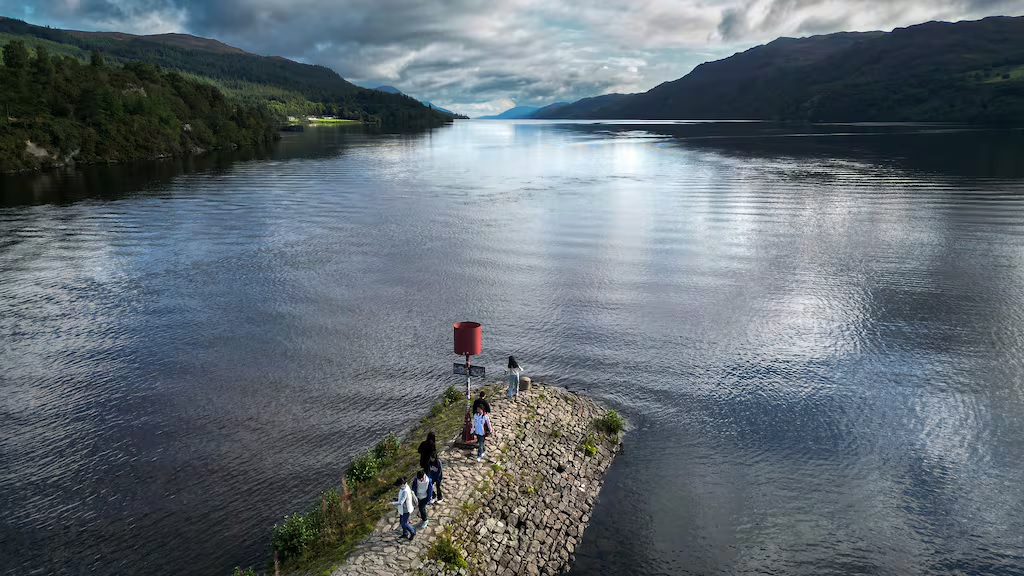The Loch Ness Monster, often affectionately called “Nessie,” is one of the world’s most famous cryptids, a creature of folklore and alleged sightings that has fascinated people for centuries. Believed to inhabit Loch Ness, a vast, deep freshwater lake in the Scottish Highlands, the legend of Nessie has generated debates, scientific investigations, and global tourism, making it an enduring cultural phenomenon.
The earliest reference to a strange creature in Loch Ness dates back to 565 AD. In this account, Saint Columba, an Irish monk, reportedly encountered a “water beast” in the River Ness while saving a man from being attacked. Columba allegedly commanded the creature to retreat, and it obeyed. While this story holds religious and historical significance, modern Nessie lore emerged in the 20th century when Loch Ness became synonymous with cryptozoological mysteries.
The sighting of the Loch Ness Monster by Aldie Mackay in 1933 is widely regarded as the moment that catapulted Nessie into modern legend. Mackay, the manager of a hotel near Loch Ness, reported seeing a “whale-like creature” in the loch while traveling along its shores with her husband. She described the creature as large, dark, and moving through the water in an extraordinary manner, creating great ripples. Her account was later relayed to the press by Alex Campbell, a water bailiff and journalist, who added vivid details, such as comparisons to a prehistoric animal.
 This account coincided with the construction of a new road along the loch, offering better views and increasing human activity in the area. Shortly after, sightings surged, and the media sensationalized reports of a “sea serpent-like” creature in the lake. That same year, the famous “Surgeon’s Photograph” was published in 1934, showing a long neck rising from the water. For decades, this black-and-white photo was considered the best evidence of Nessie’s existence. However, in 1994, it was revealed to be a hoax—a staged image using a toy submarine and a crafted head.
This account coincided with the construction of a new road along the loch, offering better views and increasing human activity in the area. Shortly after, sightings surged, and the media sensationalized reports of a “sea serpent-like” creature in the lake. That same year, the famous “Surgeon’s Photograph” was published in 1934, showing a long neck rising from the water. For decades, this black-and-white photo was considered the best evidence of Nessie’s existence. However, in 1994, it was revealed to be a hoax—a staged image using a toy submarine and a crafted head.
 Loch Ness itself plays a crucial role in sustaining the mystery. Stretching approximately 36 kilometers (22 miles) long, 1.5 kilometers (1 mile) wide, and plunging to depths of about 230 meters (755 feet), it is the second-largest loch in Scotland by surface area but the deepest by volume. Its dark, peat-stained waters often obscure visibility, creating an ideal environment for speculation about unknown creatures lurking below.
Loch Ness itself plays a crucial role in sustaining the mystery. Stretching approximately 36 kilometers (22 miles) long, 1.5 kilometers (1 mile) wide, and plunging to depths of about 230 meters (755 feet), it is the second-largest loch in Scotland by surface area but the deepest by volume. Its dark, peat-stained waters often obscure visibility, creating an ideal environment for speculation about unknown creatures lurking below.
Over the decades, hundreds of sightings have been reported, with many witnesses describing Nessie as a large, long-necked creature with humps, resembling a plesiosaur—a prehistoric marine reptile that became extinct around 66 million years ago. Skeptics argue that such descriptions are influenced by cultural references to dinosaurs, while natural explanations include misidentifications of seals, eels, floating logs, or waves. Notably, Loch Ness’s eels, which can grow to impressive sizes, are a popular scientific hypothesis for sightings.
Several organized searches have attempted to find evidence of Nessie. In 1972, the “Loch Ness Investigation Bureau” used sonar equipment to scan the depths but found no definitive proof. Similarly, in 1987, “Operation Deepscan” employed sonar technology to sweep the loch extensively. While sonar detected large, unexplained objects, they could not conclusively identify Nessie. More recently, in 2018, researchers conducted a DNA survey of Loch Ness, analyzing water samples for genetic traces of life. The study ruled out the presence of large animals like sharks or plesiosaurs but suggested that Nessie sightings might be attributed to giant eels, whose DNA was abundantly present.
Some notable sightings include the 1951 photograph by Lachlan Stuart, showing three humps in the water, and the 1960 film by Tim Dinsdale, which purportedly captured a moving object across the loch’s surface. Though intriguing, both have faced skepticism over the years. In 2007, a laboratory technician named Gordon Holmes filmed what he described as a large, jet-black creature swimming in Loch Ness, garnering media attention. Still, experts remained unconvinced.
The Loch Ness Monster continues to capture public interest through news reports, pop culture, and tourism. Loch Ness draws hundreds of thousands of visitors annually, contributing significantly to Scotland’s economy. Nessie has inspired books, documentaries, and films, including appearances in works like “The Water Horse” (2007) and countless cryptid-focused programs.
While scientific consensus leans toward skepticism, Nessie’s allure lies in its symbolic power as a creature that defies explanation. For some, Nessie represents hope that undiscovered species exist; for others, it is a modern myth fueled by imagination and misinterpretation. The debate over the Loch Ness Monster reflects a broader human fascination with mysteries, unknown realms, and the potential for wonder in the natural world. Whether real or myth, Nessie remains a cultural icon whose legend endures.

